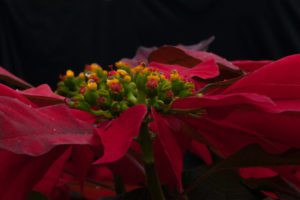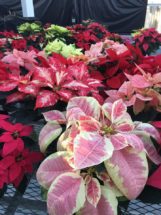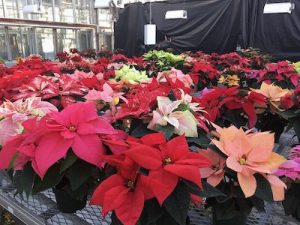Researchers manipulate daylight hours to help save poinsettias
December 8, 2021The threat comes from a phenomenon known as “heat delay” which can halt poinsettia flower development. Heat delay may cause poinsettias to mature too late for the Christmas market, resulting in revenue loss. The researchers are conducting a study to look at how rising temperatures are causing heat stress for poinsettia plants grown in greenhouses. They hope to gain a better understanding of the environmental conditions that create temperature stresses inside greenhouses so that strategies can be developed to help growers alleviate or avoid these stressors.
“Increasing temperatures are creating environments that are negatively affecting poinsettias grown in greenhouses,” said Faust, professor of floriculture physiology. “Reductions in crop quality and productivity due to the negative effects of these temperatures directly impact the profitability of commercial greenhouse producers and threaten their ability to succeed economically.”

Cyathia are the yellow flowers found in the center of the colorful bracts.
In addition to understanding environmental conditions, researchers also want to learn how to predict time-to-flower based on dynamically changing temperatures and daylight length to help growers anticipate when plants will be market ready. Results of the study, Navigating the Effects of Climate Change on the Plant Growth and Development of Greenhouse Crops also will help develop protocols for breeders to properly screen new cultivars for sensitivity to heat delay.
Appearance is a critical factor in poinsettia purchases. The leaves, or bracts, of poinsettia plants change color depending on light exposure. Cyathia are the yellow flowers found in the center of the colorful bracts. During this study, researchers will look at cyathia and bract development so that final plant quality based on appearance can be anticipated.
Growers from different locations across the United States are involved in this research.
Rising temperatures and poinsettias
Poinsettia is a short-day plant that begins to initiate flowers around September 21 when the day length is sufficiently short to initiate flowering. Eight consecutive weeks of short days are required for poinsettia flowers to develop properly.
The ideal temperatures for flower initiation are <78 degrees, while temperatures >78 degrees will delay flowering. Earth’s surface temperatures are growing warmer. Information from the National Oceanic and Atmospheric Administration (NOAA) shows average annual temperature in the contiguous 48 states has risen at an average rate of 0.16 degrees per decade since 1901. Average temperatures have risen more quickly since the late 1970s at rates of 0.31 to 0.54 degrees per decade since 1979.
“Increasing global temperatures brought on by climate change are expected to amplify the magnitude of heat delay in susceptible regions and spread this problem to new areas previously unaffected by heat delay,” said Michael Alden, a Clemson doctoral student who is working on the project.
The researchers are looking at which specific part of a 24-hour day that the plants are most susceptible to high temperature stress as this information will help growers to specifically identify which part of the day is most critical for cooling the greenhouse environment.
Helping poinsettia growers
Ivan Tchakarov, chief horticulture officer for the Metrolina Greenhouses in Charlotte, North Carolina, is working with Faust on this study. Poinsettias have been grown in the Metrolina Greenhouses for 50 years.
“Being on time with poinsettias is a must for Metrolina and delivering a great product is something we do not take lightly,” Tchakarov said. “So, after a few seasons of hot fall temperatures and production being delayed, we started extensive work on selection and growing protocols that could ensure consistent results every year.”

Over past two centuries, the poinsettia has become a Christmas icon, surpassing holly, ivy and mistletoe as the Christmas plant.
Tchakarov and his staff have been working with Faust on other projects for about 10 years. When they started noticing flowering delays in their poinsettias, they asked Faust to help them find a solution.
“Dr. Faust picked varieties that are typically grown in the South and that we grow,” Tchakarov said. “We set different daylight (black-out) trials to see what would happen when applying shorter days to the crop and to what extent we could overcome heat delays during flower initiation and response time of the crop.”
More than 3 million pots of poinsettias are planted each year in the Metrolina Greenhouses. With Faust’s help, Tchakarov said they were successful in determining how to overcome the flowering delays.
“In 2018 when September’s average temperatures were in the 80s and sometimes, reaching the 90s, we were using Dr. Faust’s technique and were successful with our poinsettias,” Tchakarov said. “None were late, and we produced plants of a very good quality. This is a technique we still use and will be using for quite some time. Dr. Faust’s work has been proven essential to our success and we will continue to work with him closely.”
In addition to Faust and Alden, other researchers for the project are Clemson master’s student Paul Miller, Texas A&M floriculture professor Brent Pemberton and University of Florida floriculture professor and Extension specialist Paul Fisher.
Over past two centuries, the poinsettia has become a Christmas icon, surpassing holly, ivy and mistletoe as the Christmas plant. It is native to Mexico and Guatemala and was named for the native South Carolinian and the first American ambassador to Mexico, Joel Poinsett. Poinsett, an avid horticulturist, collected a poinsettia in Taxco, Mexico in 1828 and shipped it in a collection of plants to the Bartram’s Garden in Philadelphia, Pennsylvania, where it quickly became popular in the United States and Europe.














